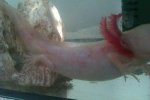Salt baths are a bad idea, they will make the skin worse. Only do them if you see fungus on your axolotl.
At the moment you need to do regular and small water changes in your tank to remove any build up of ammonia, nitrite or nitrate. It's best to buy a test kit so you can check the water. It really does help and axies need clean water to survive. API master test kits might look like a lot of money but they last a long time.
This is the copy of tea bath instructions from the caudata culture website. It would help your axolotls skin.
Tea bath for axolotls
Contributed by Daniel Weiner, August 2007.
I mainly use teabaths for minor skin problems. It may also be used with fungal problems but on that account I prefer salt baths. Tea has a slightly antifungal and antibacterial effect (resulting from tannins) and additionally it closes the pores in the skin a little bit (mainly resulting from tannin and caffeine). The skin tightens and gets some kind of protective layer, making it harder for fungi and bacteria to intrude the body. On the other hand it makes it harder for salt or medicine to reach pathogens which are already inside the body - that is the reason I do not use it on fungal infections, although a tea bath is sometimes recommended as a cure for fungal infections by some people.
The medication is as follows: I take one bag of black tea without any additional aroma (it is important to use black tea because this kind of tea is fermented and so it has tannins) for every 10 litres of water (preferably used in a quarantine tank). This tea gets dashed with boiling water in a seperate bowl - I leave it there for at least 10 to 15 minutes so the tannins are resolved into the water. The tea has to cool down and is finally added to the quarantine water. After a week I make a bigger change of water (60% at least), the rest of the tea is removed over time by normal water changes. If you have to make more regular water changes (f.i. in a small bowl or tank) the tea concentration can be refilled. As far as I know there are no negative effects even for long term treatment.
A similar effect (although not as strong) may have the addition of dried oak or beech leafs now and then as a precaution.






